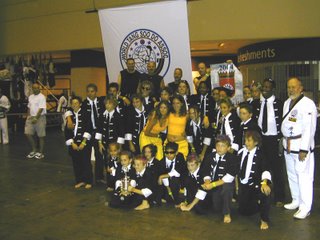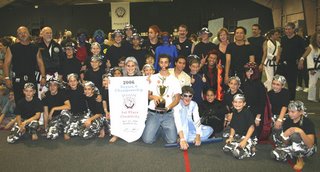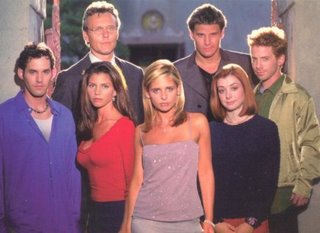Demo #1) Army of Me, 2002

Story Rundown:
Two spirits of nature battle a tyrant bent on destroying the Earth.
Songs & Inspirations:
Army of Me, Bjork
The Lord of the Rings, dir. Peter Jackson
History:
This was the first demo performed by the newly reinstated Demo Team, which suffered a loss of leadership the year before. Demo team captains included me and Mr. Francis, and the lead roles were played by Nick Lucas, Melissa Jaworski and John Jaworski. Sets were provided by Yaz.
Favorite Moments:
- Mr. Francis’s "monkey-crab-walk"
- Melissa's "acting" (which basically consisted of a lot of screaming)
- Josh's lines: "That ain't right!" and "That's gotta hurt!";
Verdict:
“Army of Me” was not the best of our demos, but it was a good start that earned us a third place award at the 2002 Region 8 Tournament. It's unavoidable and inherent cheesiness has earned a special place my heart, and I think of it every time I hear Bjork's Army of Me on the radio.
Demo #2) Showdown at the House of Blues , 2004
 Story Rundown:
Story Rundown:
No story, really. This one is all about image and attitude. 20 kids dressed like the Blues Brothers, perform group hyungs, board breaks, weapons drills and self-defense techniques to hip-hop and rock music. It doesn't get much cooler than that!
Songs & Inspirations:
Kill Bill, dir. Quentin Tarantino
It Takes Two, DJ Kool and Fatman Scoop
Get Free, The Vines
History:
The Demo Team decided to compete on the world stage as part of the WTSDA's World Tournament in Orlando, Florida. In order to pay for the costumes and for the costs associated with the trip, the Demo Team embarked on an extensive fundraising campaign in addition to the long hours of practice. Not only did the kids knit together for the cause, the parent's got involved further tightening the bonds of friendship between the Demo Team members.
Favorite Moments:
- The whole Florida Trip
- The beginning of the multi-colored hair tradition.
Verdict:
This demo earned us a third place award at the 2004 World Tournament, and was a crowd favorite. Our dance/hyung/drill performance, inspired by step routines and party walks from African-American Colleges was unique. This was the start of the Demo Team's tradition for wacky hair styles and rhythmic performances and the kids earned special notice from a few master instructors. People began to take a really good look at Vaughn’s Demo Team, and were particularly impressed by the special bond they had for each other.
Demo #3) "Big Dogs Bark!", 2004

Story Rundown:
Again, this one is all about image & attitude. The story can be summed up as: "Two gangs fight." But add a TSD hyung/step routine to the a classic funk tune, and the Demo Team out cool's itself yet again!
Songs & Inspirations:
Atomic Dog, George Clinton. Make my funk the P-funk, y'all!
History:
This is the first Demo completely conceptualized and captained by a youth black belts. The adults provided logistical guidance but the kids, lead by Nick Lucas and Melissa Jaworski, stepped up to the plate as creatively. Team organization included back-up up by talented (but unofficial) co-captains Mike Papp and Lauren Luneau.
Favorite Moments:
- "Big Dawgs Bark! AAAARRROOOO!"
Verdict:
This demo won second place in the 2004 Region 8 Tournament, missing first place by 0.1 points! This was the apex of the team’s tradition for wacky hair styles and rhythmic performances, and it proved that Vaughn's Dojang's youth black belts had the class and style to compete with the Region 8's adult black belts.
Demo #4) James Bond meets Austin Powers, 2006

Story Rundown:
After battling many femme fatales, James Bond meets the true International Man of Mystery.
Songs & Inspirations:
James Bong Theme, Monty Norman
Soul Bossa Nova, Quincy Jones
History:
Demo Team leadership suffered another massive shake-up. Youth captains, Nick and Melissa, went off to college. Both adult supervisors, Mr. Williams and Mr. Francis packed up their families and moved either out-of-state or out-of-country. The big question was: “Who was going to take over the demo team?”
The mantle of leadership transferred to Mike Papp and Lauren Luneau, backed by Mr. Papp, the Senior. These three lead a crew Demo Team veterans plus a new generation of up-and-comers from the ranks of Vaughn's gup students to the 2005 World Tournament in Anaheim, California. This demo was made in during a contentious transitional period, but the team pulled through.
Favorite Moments:
- Andrew Delena as "Austin Powers", of course (I think Master Britt would agree)
Verdict:
This demo third place award and was a great satire on our tradition of "dancing". The team proved that the Demo Team was a legacy, and the sprit of teamwork, creativity and initiative helped to inspire a new generation of kids. The Demo Team is here to stay!
Demo #5) X-Men: The Last Stand, 2006

Story Rundown:
The coolest adaptation of the X-Men movies, ever!
Songs & Inspirations:
X-Men: The Last Stand, dir. Brett Ratner
Music arranged by Mike Papp
History:
A true creative milestone for the Demo Team. This demo had everything! Great fight scenes, special effects and props (blood squibs, Wolverines claws), awesome costumes and superb set design, including an imploding army barracks! The pageant required the cooperation of youth and parents and was funded by significant fundraising efforts by the team. Stylistically, this demo was a departure from the wacky hair/dancing themes, returning to a more classic performance structure while retaining much of the attitude and imagery that defined all of Vaughn’s Dojangs Demo Team creative efforts. Each performer was at the top of their game. The younger kids (representing the Human Army) performed spectacular weapons forms, using knives and guns. The older demo veterans each performed as members of the Brotherhood of Evil Mutants and the X-Men, with Mike Papp as a truly cool Wolverine, complete with retractable claws!
Favorite Moments (almost too many to mention):
- Each team member performing their fight scene exactly as the corresponding character would fight
- Original knife hyung, performed flawlessly by the youngest kids on the team
- Miram's ki haps during the gun form
- Toad (James Bonny) fighting Gambit (Lisa Collins)
- Beast (Tyler Yaz) pummeling the hell out of Quicksilver (Andrew Delena)
- Iceman (Eddie Newman) "freezing" Pyro (Patrick Vu) and then accidentally getting stuck on the ammo boxes
- Lady Deathstrike (Erica Papp) fighting Wolverine. This fight scene was too short. I want to see Erica in more fight scenes. I could watch her beat up on her brother all day!
- Sabertooth (Josh Lucas) vs. Wolverine! Too bloody! Too cool!
- The final pose at the end of the demo.
Verdict:
First Place 2006 Region 8 Tournament (coincidentally by 0.1 points). 'Nuff said!





